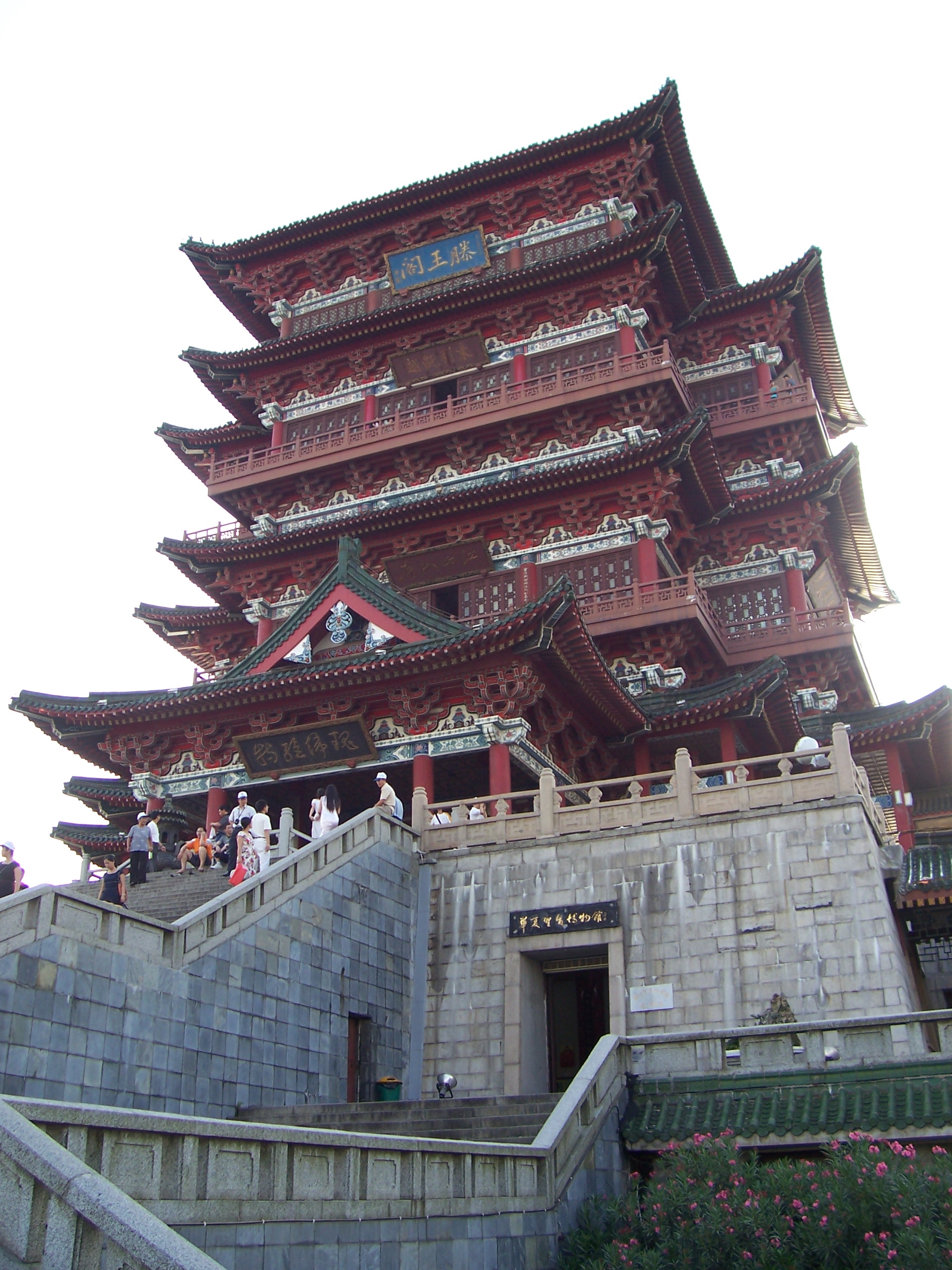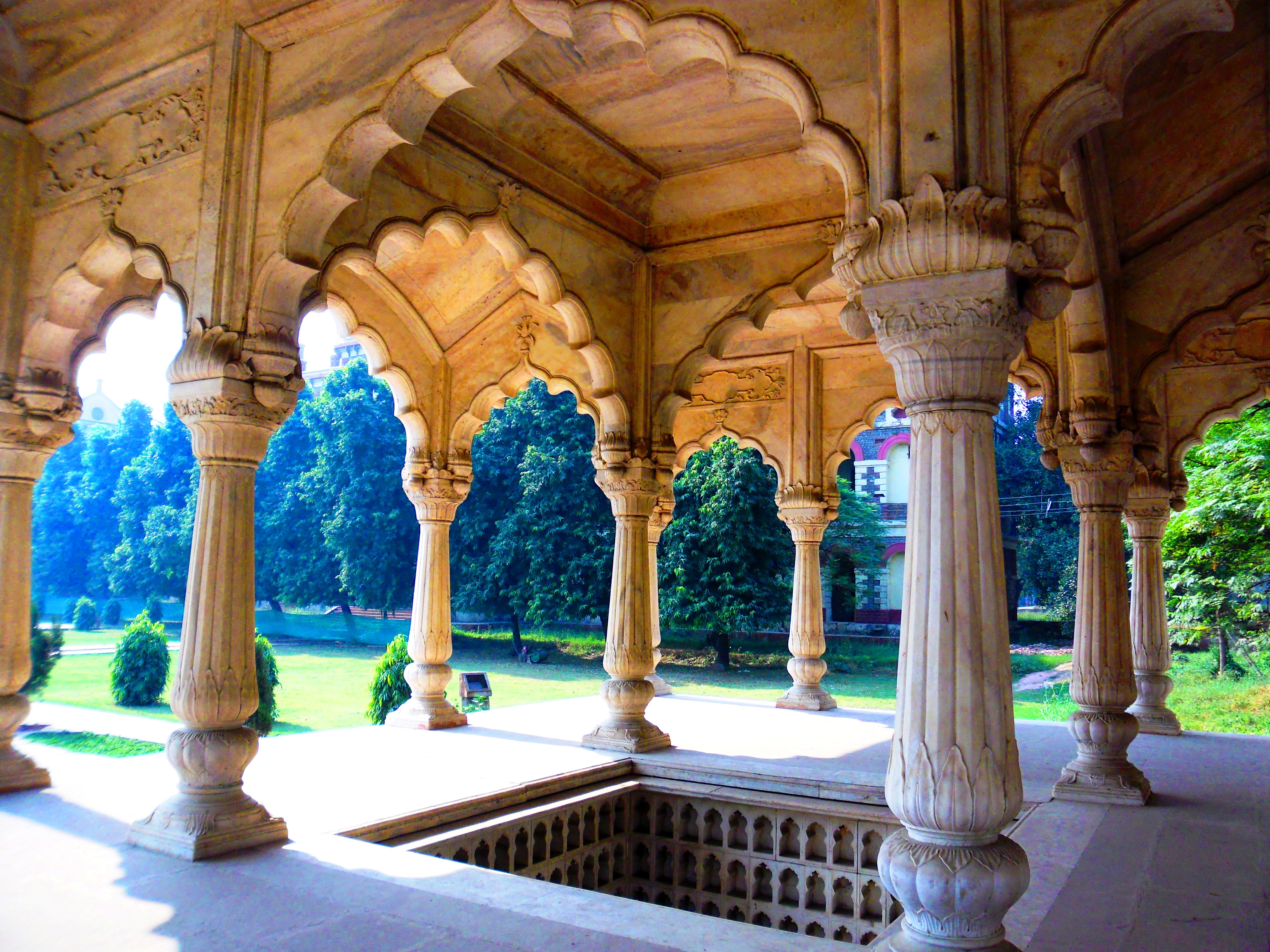|
Tengwang Pavilion
The Pavilion of Prince Teng () is a building in the North West of the city of Nanchang, in Jiangxi province, China, on the east bank of the Gan River and is one of the Three Great Towers of southern China. The other two are the Yueyang Tower and the Yellow Crane Pavilion. It has been destroyed and rebuilt many times over its history. The present building was rebuilt in 1989 on the original site. The rebuilding plan was devised by the architect Liang Sicheng, and now the Pavilion of Prince Teng is the landmark of Nanchang. There are nine floors in total. The main architectural structure is in Song dynasty wooden style, showing the magnificence of the Pavilion. History The Pavilion of Prince Teng was first built in 653 AD, by Li Yuanying, the younger brother of Emperor Taizong of Tang and uncle of Emperor Gaozong of Tang. Li Yuanying was enfeoffed as Prince Teng in 639 and spent his early years in Suzhou. In 652 he was assigned the governorship of Nanchang where the pavilion se ... [...More Info...] [...Related Items...] OR: [Wikipedia] [Google] [Baidu] |
Pavilion Of Prince Teng 3
In architecture, ''pavilion'' has several meanings; * It may be a subsidiary building that is either positioned separately or as an attachment to a main building. Often it is associated with pleasure. In palaces and traditional mansions of Asia, there may be pavilions that are either freestanding or connected by covered walkways, as in the Forbidden City (Chinese pavilions), Topkapi Palace in Istanbul, and in Mughal architecture, Mughal buildings like the Red Fort. * As part of a large palace, pavilions may be symmetrically placed building ''blocks'' that flank (appear to join) a main building block or the outer ends of wings extending from both sides of a central building block, the ''corps de logis''. Such configurations provide an emphatic visual termination to the composition of a large building, akin to bookends. The word is from French language, French (Old French ) and it meant a small palace, from Latin (accusative of ). In Late Latin and Old French, it meant both ‘b ... [...More Info...] [...Related Items...] OR: [Wikipedia] [Google] [Baidu] |
Tongzhi Emperor
The Tongzhi Emperor (27 April 1856 – 12 January 1875), also known by his temple name Emperor Muzong of Qing, personal name Zaichun, was the ninth emperor of the Qing dynasty, and the eighth Qing emperor to rule over China proper. His reign, which effectively lasted through his adolescence, was largely overshadowed by the rule of Empress Dowager Cixi. Although he had little influence over state affairs, the events of his reign gave rise to what historians call the " Tongzhi Restoration", an unsuccessful modernization program. The only surviving son of the Xianfeng Emperor, he ascended the throne at the age of five under a regency headed by his biological mother Empress Dowager Cixi and his legal mother Empress Dowager Ci'an. The Self-Strengthening Movement, in which Qing officials pursued radical institutional reforms following the disasters of the Opium Wars and the Taiping Rebellion, began during his reign. The Tongzhi Emperor assumed personal rule over the Qing governme ... [...More Info...] [...Related Items...] OR: [Wikipedia] [Google] [Baidu] |
Ming Dynasty
The Ming dynasty, officially the Great Ming, was an Dynasties of China, imperial dynasty of China that ruled from 1368 to 1644, following the collapse of the Mongol Empire, Mongol-led Yuan dynasty. The Ming was the last imperial dynasty of China ruled by the Han people, the majority ethnic group in China. Although the primary capital of Beijing fell in 1644 to a rebellion led by Li Zicheng (who established the short-lived Shun dynasty), numerous rump state, rump regimes ruled by remnants of the House of Zhu, Ming imperial family, collectively called the Southern Ming, survived until 1662. The Ming dynasty's founder, the Hongwu Emperor (1368–1398), attempted to create a society of self-sufficient rural communities ordered in a rigid, immobile system that would guarantee and support a permanent class of soldiers for his dynasty: the empire's standing army exceeded one million troops and the naval history of China, navy's dockyards in Nanjing were the largest in the world. H ... [...More Info...] [...Related Items...] OR: [Wikipedia] [Google] [Baidu] |
Zhu Chenhao
Zhu Chenhao (1 July 1476 – 13 January 1521), art name Weitian, was a prince of the Ming dynasty, being a fifth-generation descendant of Zhu Quan, the seventeenth son of the founder and first emperor of the dynasty, the Hongwu Emperor. In 1499, he inherited the title of Prince of Ning and resided in Nanchang, the capital of Jiangxi. However, in July 1519, he started a rebellion by declaring the then Zhengde Emperor illegitimate and marching on Nanjing. Wang Yangming, governor of southern Jiangxi, quickly raised an army and occupied Nanchang. In August 1519, he crushed the rebel army, forcing them to retreat to the south. During the battle, Zhu Chenhao was captured and sentenced to death, but the emperor later commuted his sentence to suicide. Biography Prince of Ning Zhu Chenhao was the fifth-generation descendant of Zhu Quan, the first Prince of Ning and the seventeenth son of the Hongwu Emperor. His father, Zhu Jinjun (; 1449–1497), was the Prince of Shanggao () and later of ... [...More Info...] [...Related Items...] OR: [Wikipedia] [Google] [Baidu] |
Forbidden City
The Forbidden City () is the Chinese Empire, imperial Chinese palace, palace complex in the center of the Imperial City, Beijing, Imperial City in Beijing, China. It was the residence of 24 Ming dynasty, Ming and Qing dynasty, Qing dynasty List of Chinese monarchs, Emperors, and the center of political power in China for over 500 years from 1420 to 1924. The palace is now administered by the Palace Museum. As a World Heritage Site, UNESCO World Heritage Site, it is one of the most popular tourist attractions in the world. The Forbidden City is arguably the most famous Chinese palace, palace in all of History of China, Chinese history, and is the largest preserved Palace, royal palace complex still standing in the world. The Forbidden City was constructed from 1406 to 1420, and was the imperial palace and winter residence of the Emperor of China from the Ming dynasty (since the Yongle Emperor) to the end of the Qing dynasty, between 1420 and 1924. The Forbidden City served as ... [...More Info...] [...Related Items...] OR: [Wikipedia] [Google] [Baidu] |
Mao Zedong
Mao Zedong pronounced ; traditionally Romanization of Chinese, romanised as Mao Tse-tung. (26December 18939September 1976) was a Chinese politician, revolutionary, and political theorist who founded the People's Republic of China (PRC) in 1949 and led the country from Proclamation of the People's Republic of China, its establishment until Death and state funeral of Mao Zedong, his death in 1976. Mao served as Chairman of the Chinese Communist Party (CCP) from 1943 until his death, and as the party's ''de facto'' leader from 1935. His theories, which he advocated as a Chinese adaptation of Marxism–Leninism, are known as Maoism. Born to a peasant family in Shaoshan, Hunan, Mao studied in Changsha and was influenced by the 1911 Revolution and ideas of Chinese nationalism and anti-imperialism. He was introduced to Marxism while working as a librarian at Peking University, and later participated in the May Fourth Movement of 1919. In 1921, Mao became a founding member of the ... [...More Info...] [...Related Items...] OR: [Wikipedia] [Google] [Baidu] |
Chinese City Wall
Chinese city walls () refer to defensive walls built to protect important towns and cities in pre-modern China. In addition to walls, Chinese city defenses also included fortified towers and city gate, gates, as well as moats and rampart (fortification), ramparts around the walls. Meaning of the word ''Chengqiang'' The most specific Chinese language, Chinese word for a city wall is ''chéngqiáng'' (城墙), which can be used in two senses in the modern Chinese language. It broadly refers to all defensive walls, including the Great Wall of China, as well as similar defensive structures in areas outside of China such as Hadrian's Wall. More specifically Chengqiang refers to defensive walls built around a city or town. However, in classical Chinese, the character ''chéng'' (城) denoted the defensive wall of the "inner city" which housed government buildings. The character ''guō'' (郭) denoted the defensive wall of the "outer city", housing mainly residences. The phrase chángc ... [...More Info...] [...Related Items...] OR: [Wikipedia] [Google] [Baidu] |
Song Dynasty
The Song dynasty ( ) was an Dynasties of China, imperial dynasty of China that ruled from 960 to 1279. The dynasty was founded by Emperor Taizu of Song, who usurped the throne of the Later Zhou dynasty and went on to conquer the rest of the Five Dynasties and Ten Kingdoms period#Ten Kingdoms, Ten Kingdoms, ending the Five Dynasties and Ten Kingdoms period. The Song frequently came into conflict with the contemporaneous Liao dynasty, Liao, Western Xia and Jin dynasty (1115–1234), Jin dynasties in northern China. After retreating to southern China following attacks by the Jin dynasty, the Song was eventually conquered by the Mongol-led Yuan dynasty. The History of the Song dynasty, dynasty's history is divided into two periods: during the Northern Song (; 960–1127), the capital was in the northern city of Bianjing (now Kaifeng) and the dynasty controlled most of what is now East China. The #Southern Song, 1127–1279, Southern Song (; 1127–1279) comprise the period following ... [...More Info...] [...Related Items...] OR: [Wikipedia] [Google] [Baidu] |
Reinforced Concrete
Reinforced concrete, also called ferroconcrete or ferro-concrete, is a composite material in which concrete's relatively low tensile strength and ductility are compensated for by the inclusion of reinforcement having higher tensile strength or ductility. The reinforcement is usually, though not necessarily, steel reinforcing bars (known as rebar) and is usually embedded passively in the concrete before the concrete sets. However, post-tensioning is also employed as a technique to reinforce the concrete. In terms of volume used annually, it is one of the most common engineering materials. In corrosion engineering terms, when designed correctly, the alkalinity of the concrete protects the steel rebar from corrosion. Description Reinforcing schemes are generally designed to resist tensile stresses in particular regions of the concrete that might cause unacceptable cracking and/or structural failure. Modern reinforced concrete can contain varied reinforcing materials made o ... [...More Info...] [...Related Items...] OR: [Wikipedia] [Google] [Baidu] |
View From Top Of Tengwangge (Prince Of Teng Pavilion) (31445668861)
Acornsoft was the software arm of Acorn Computers, and a major publisher of software for the BBC Micro and Acorn Electron. As well as games, it also produced a large number of educational titles, extra computer languages and business and utility packages – these included word processor ''VIEW'' and the spreadsheet ''ViewSheet'' supplied on ROM and cartridge for the BBC Micro/Acorn Electron and included as standard in the BBC Master and Acorn Business Computer. History Acornsoft was formed in late 1980 by Acorn Computers directors Hermann Hauser and Chris Curry, and David Johnson-Davies, author of the first game for a UK personal computer and of the official Acorn Atom manual "Atomic Theory and Practice". David Johnson-Davies was managing director and in early 1981 was joined by Tim Dobson, Programmer and Chris Jordan, Publications Editor. While some of their games were clones or remakes of popular arcade games (e.g. ''Hopper'' is a clone of Sega's ''Frogger'', '' Snapper' ... [...More Info...] [...Related Items...] OR: [Wikipedia] [Google] [Baidu] |







